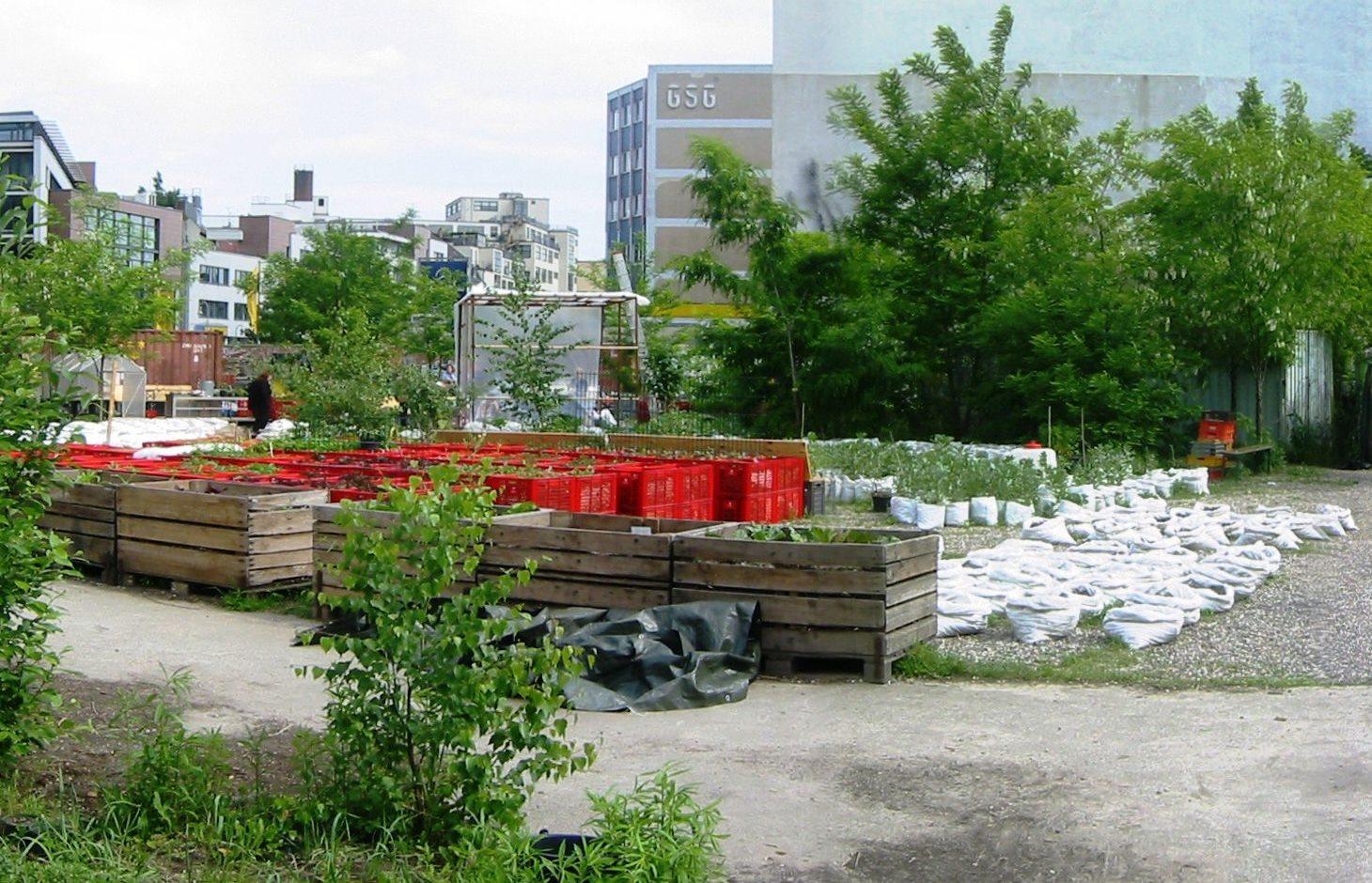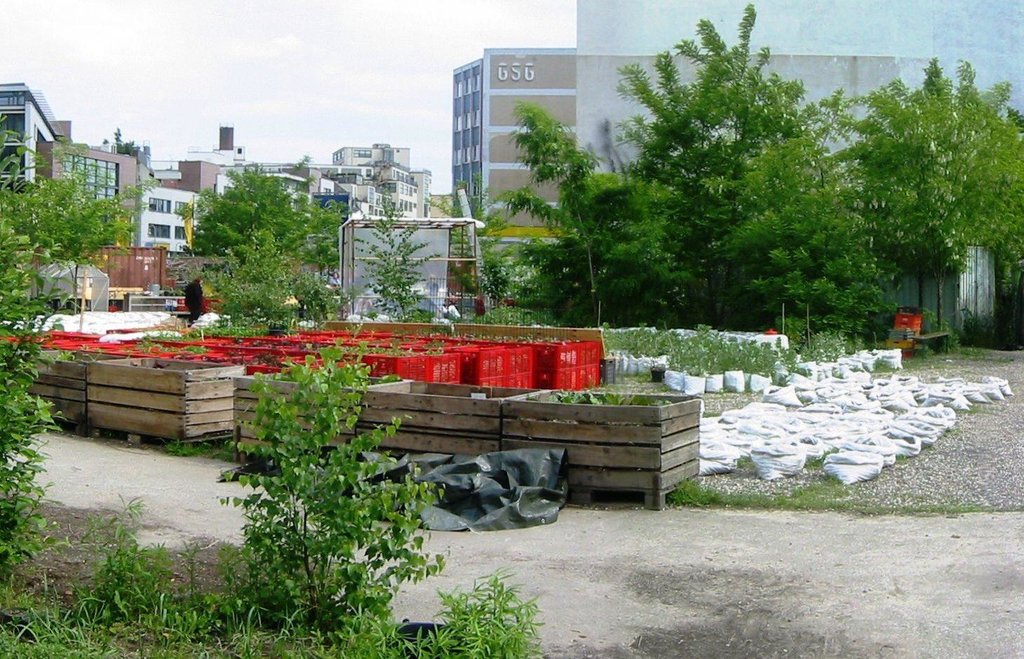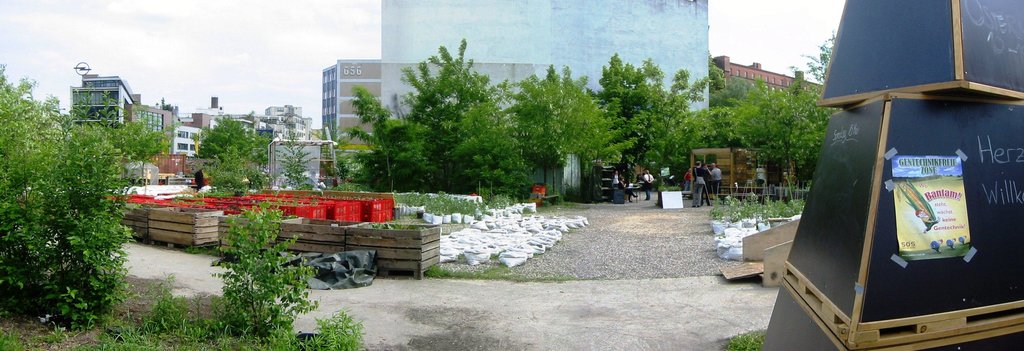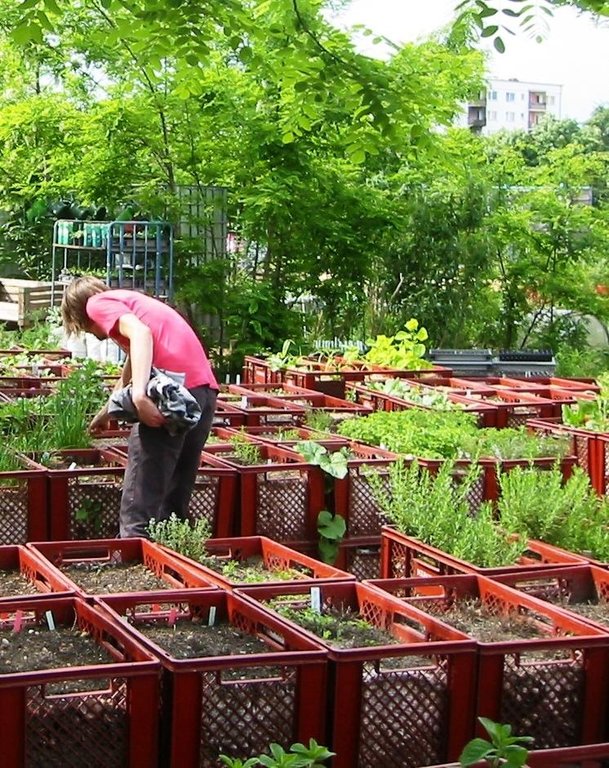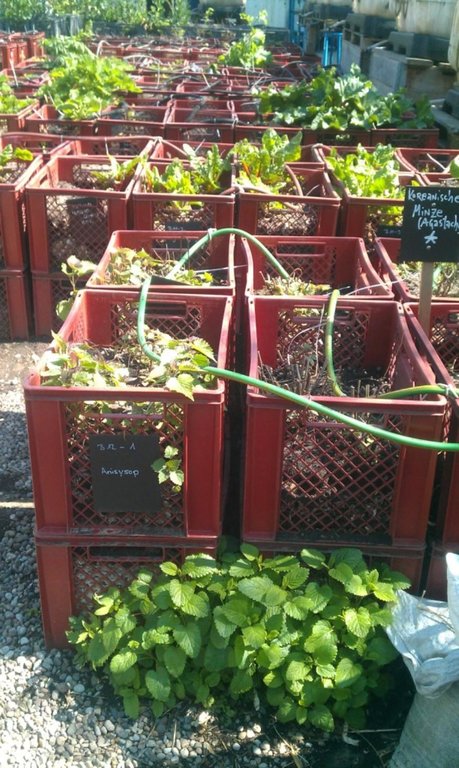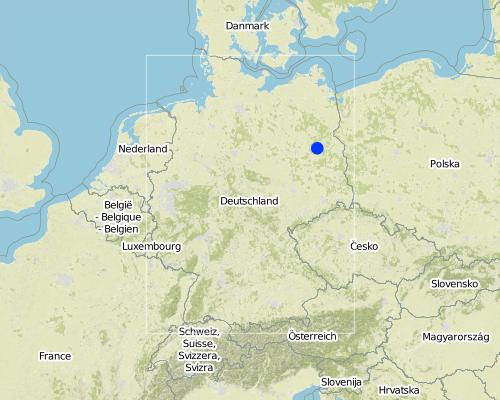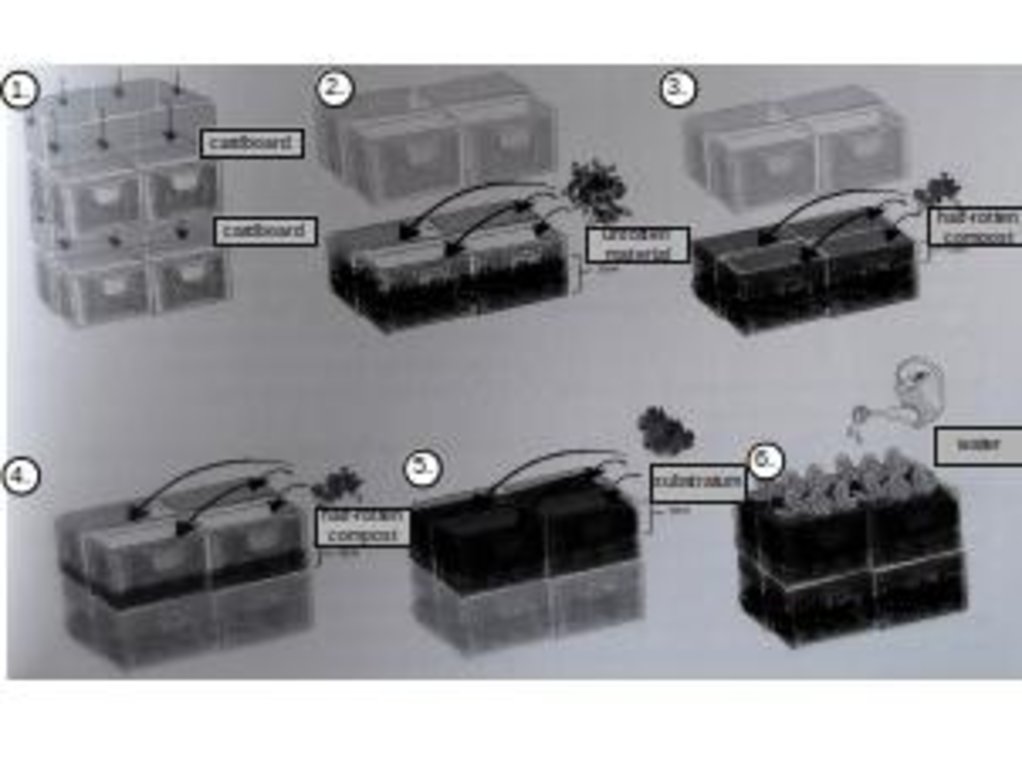Mobile cultivation beds [德国]
- 创建:
- 更新:
- 编制者: Peter Kirch
- 编辑者: –
- 审查者: Fabian Ottiger
technologies_1678 - 德国
查看章节
全部展开 全部收起1. 一般信息
1.2 参与该技术评估和文件编制的资源人员和机构的联系方式
关键资源人
土地使用者:
Shaw Robert
+49(0)17624332297
rs@prinzessinnengarten.net
Nomadisch Grün gemeinnützige GmbH
Forster Str. 5, 10999 Berlin, HRB 121043 B 3
德国
Bärich Christian
SLM专业人员:
有助于对技术进行记录/评估的机构名称(如相关)
Nomadisch grün GmbH - 德国有助于对技术进行记录/评估的机构名称(如相关)
Humboldt Universität zu Berlin (HU Berlin) - 德国1.3 关于使用通过WOCAT记录的数据的条件
(现场)数据是什么时候汇编的?:
08/05/2015
编制者和关键资源人员接受有关使用通过WOCAT记录数据的条件。:
是
2. SLM技术的说明
2.1 技术简介
技术定义:
Mobile vegetable cultivation system for urban areas with "baker boxes" as main elements.
2.2 技术的详细说明
说明:
The main technology applied in the urban gardening project "Princess gardens" can be described as mobile vegetable culitivation system based on the use of "baker boxes".
"Baker boxes" are plastic boxes (size: average area of 40 cm x 60 cm x 35 cm) made out of heat-resistant materials, which do not contain softeners. The bottom part as well as the side parts are formed in a grid pattern (holes of 1cm³ size).
For the vegetable production, cultivation units ("box towers" ) are built out of two boxes by placing them on top of each other. The lower box is filled with organic material (composition of the material like in a compost) and the upper box is filled with garden mould (or other earth material suitable for cultivation). To prevent the washing out of earth material through the grid pattern, carton is put on the bottom as well as on the side walls of the upper box.
During a period of time (length can vary from 1 to 3 years) the upper box can be cultivated according to the principles of "good practise" (e.g. crop rotation). During this time, the lower box serves as compost. In the course of each year this box is checked if the ongoing decomposition processes have lead to the creation of free space in the box. In this case, organic material needs to be refilled.
In the end of the 1-3 years-cultivation period the upper box is emptied and the contained earth material can be used for purposes such as landscaping. The box is then filled with organic material and switched with the lower box, which should contain "ready to cultivate"-compost material. The cultivation can then be restarted.
Purpose of the Technology: The purpose of the technology is to allow cultivation on sealed or contaminated soils. Through the use of the box towers as cultivation units the roots of the plants never get in touch with the soil. While the main rooting zone is to be found in the upper box, deeper rooting plants can grow down to 70 cm into the lower box without reaching the soil in place.
Another purpose of the technology is to create a mobile cultivation system. If needed, the boxes can be easily moved away even during the vegeation period.
Last but not least, the technology has the purpose to create a space, where knowledge sharing on a practical basis regarding the topics e.g. agriculture, sustainability and health can take place.
Establishment / maintenance activities and inputs: For the establishment of the technology first and foremost a sufficient number (depending on the size of the gardening area) of "baker boxes" is needed.
Maintenance activities consist of refilling the lower box with organic material.
This is also true for the required inputs.
Natural / human environment: The environment is strongly influenced by humans, as the first urban structures in this area already were established about 200 years ago. Regarding the topic soil this led to the conversion of the natural soils in place to Technosols.
2.3 技术照片
2.5 已应用该技术的、本评估所涵盖的国家/地区/地点
国家:
德国
区域/州/省:
Berlin
Map
×3. SLM技术的分类
3.2 应用该技术的当前土地利用类型

定居点、基础设施
- 定居点、建筑物
- 交通:公路、铁路
注释:
Major land use problems (compiler’s opinion): The major land use problem can be addressed as a lack of cultivation plots within the urban areas. This is due to the fact that the soils are to a great extent sealed or contaminated.
As a result in the urban area there is also a lack of pratical learning areas which relate to the topics agriculture and soils.
Major land use problems (land users’ perception): As major land use problems the cultivation circumstances are regarded. This inculdes the topics of destroyed natural soil fertility and a lack of water infiltration into the ground.
Constraints of settlement / urban
Constraints of infrastructure network (roads, railways, pipe lines, power lines)
3.3 有关土地利用的更多信息
每年的生长季节数:
- 1
具体说明:
Longest growing period in days: 200Longest growing period from month to month: April to October
3.4 该技术所属的SLM组
- Cultivation on sealed or contaminated soils
3.5 技术传播
具体说明该技术的分布:
- 均匀地分布在一个区域
如果该技术均匀地分布在一个区域上,请注明覆盖的大致区域。:
- < 0.1 平方千米(10 公顷)
注释:
Total area covered by the SLM Technology is 0,006 m2.
3.6 包含该技术的可持续土地管理措施

结构措施
- S11:其它

管理措施
- M6:废物管理(回收、再利用或减少)
注释:
Main measures: structural measures, management measures
Specification of other structural measures: creation of cultivation plots
3.7 该技术强调的主要土地退化类型

物理性土壤退化
- Pk:熟化和结壳
- Pu:由于其他活动而导致生物生产功能的丧失
注释:
Main type of degradation addressed: Pk: sealing and crusting, Pu: loss of bio-productive function due to other activities
Main causes of degradation: urbanisation and infrastructure development (1 sealing (foundations of buildings were constructed in the area))
Secondary causes of degradation: population pressure (as a main cause for urbanisation), inputs and infrastructure: (roads, markets, distribution of water points, other, …) (need for public services in the city), governance / institutional (urban planning in the city)
3.8 防止、减少或恢复土地退化
注释:
Main goals: rehabilitation / reclamation of denuded land
Secondary goals: prevention of land degradation, mitigation / reduction of land degradation
4. 技术规范、实施活动、投入和成本
4.1 该技术的技术图纸
4.2 技术规范/技术图纸说明
edited by Peter Kirch on the basis of Daniel Müller/dkmnews in „Prinzessinengärten- Anders gärtnern in der Stadt“, Nomadisch Grün (Hg.),Dumont Buchverlag, Köln, 2012, page. 115
Location: Berlin. Germany
Date: 08.10.2015
Technical knowledge required for land users: moderate
Main technical functions: increase of biomass (quantity), promotion of vegetation species and varieties (quality, eg palatable fodder), spatial arrangement and diversification of land use
Structural measure: boxes
Spacing between structures (m): various
Depth of ditches/pits/dams (m): 0,35
Width of ditches/pits/dams (m): 0,4
Length of ditches/pits/dams (m): 0,6
Construction material (other): plastic (food-safe)
Change of land use type: urban area to urban gardening area
Layout change according to natural and human environment: area is limited through infrastructure elements (roads) and buildings.
4.3 有关投入和成本计算的一般信息
其它/国家货币(具体说明):
Euro
注明美元与当地货币的汇率(如相关):1美元=:
0.9
4.4 技术建立活动
| 活动 | 措施类型 | 时间 | |
|---|---|---|---|
| 1. | putting boxes in place | 结构性的 |
4.8 影响成本的最重要因素
描述影响成本的最决定性因素:
Costs are affected by the wages for the employees and the rent of the plot
5. 自然和人文环境
5.1 气候
年降雨量
- < 250毫米
- 251-500毫米
- 501-750毫米
- 751-1,000毫米
- 1,001-1,500毫米
- 1,501-2,000毫米
- 2,001-3,000毫米
- 3,001-4,000毫米
- > 4,000毫米
农业气候带
- 半湿润
Thermal climate class: temperate
5.2 地形
平均坡度:
- 水平(0-2%)
- 缓降(3-5%)
- 平缓(6-10%)
- 滚坡(11-15%)
- 崎岖(16-30%)
- 陡峭(31-60%)
- 非常陡峭(>60%)
地形:
- 高原/平原
- 山脊
- 山坡
- 山地斜坡
- 麓坡
- 谷底
垂直分布带:
- 0-100 m a.s.l.
- 101-500 m a.s.l.
- 501-1,000 m a.s.l.
- 1,001-1,500 m a.s.l.
- 1,501-2,000 m a.s.l.
- 2,001-2,500 m a.s.l.
- 2,501-3,000 m a.s.l.
- 3,001-4,000 m a.s.l.
- > 4,000 m a.s.l.
5.3 土壤
平均土层深度:
- 非常浅(0-20厘米)
- 浅(21-50厘米)
- 中等深度(51-80厘米)
- 深(81-120厘米)
- 非常深(> 120厘米)
土壤质地(表土):
- 粗粒/轻(砂质)
表土有机质:
- 低(<1%)
如有可能,附上完整的土壤描述或具体说明可用的信息,例如土壤类型、土壤酸碱度、阳离子交换能力、氮、盐度等。:
Soil fertility is very low
Soil drainage/infiltration is poor
Soil water sotrage capacity is very low
5.4 水资源可用性和质量
地下水位表:
5-50米
地表水的可用性:
好
水质(未处理):
仅供农业使用(灌溉)
关于水质和水量的注释和进一步规范:
Seasonality of water quality and source of pollution: for agricultural use only (rainwater)
5.5 生物多样性
物种多样性:
- 中等
5.6 应用该技术的土地使用者的特征
非农收入:
- > 收入的50%
个人或集体:
- 团体/社区
性别:
- 女人
- 男人
说明土地使用者的其他有关特征:
Population density: > 500 persons/km2
Annual population growth: 2%
Relative level of wealth: very rich, rich, very poor
1% of the land users are very rich.
5% of the land users are rich.
50% of the land users are average wealthy.
40% of the land users are poor.
4% of the land users are poor.
5.7 应用该技术的土地使用者拥有或租用的平均土地面积
- < 0.5 公顷
- 0.5-1 公顷
- 1-2 公顷
- 2-5公顷
- 5-15公顷
- 15-50公顷
- 50-100公顷
- 100-500公顷
- 500-1,000公顷
- 1,000-10,000公顷
- > 10,000公顷
这被认为是小规模、中规模还是大规模的(参照当地实际情况)?:
- 小规模的
5.8 土地所有权、土地使用权和水使用权
土地所有权:
- 社区/村庄
土地使用权:
- 租赁
5.9 进入服务和基础设施的通道
健康:
- 贫瘠
- 适度的
- 好
教育:
- 贫瘠
- 适度的
- 好
技术援助:
- 贫瘠
- 适度的
- 好
就业(例如非农):
- 贫瘠
- 适度的
- 好
市场:
- 贫瘠
- 适度的
- 好
能源:
- 贫瘠
- 适度的
- 好
道路和交通:
- 贫瘠
- 适度的
- 好
饮用水和卫生设施:
- 贫瘠
- 适度的
- 好
金融服务:
- 贫瘠
- 适度的
- 好
6. 影响和结论性说明
6.1 该技术的现场影响
社会经济效应
生产
作物生产
SLM之前的数量:
0
SLM之后的数量:
100
产品多样性
生产区域
收入和成本
农业收入
SLM之前的数量:
0
SLM之后的数量:
100
收入来源的多样性
社会文化影响
食品安全/自给自足
健康状况
文化机会
娱乐机会
社区机构
国家机构
社会经济弱势群体的情况
Improved livelihoods and human well-being
注释/具体说明:
The "Prinzessinnengarten" is more than just a place to grow vegetables in the city. It is a space for diverse activities. Through the opportunity to contribute and to participate in open workshops, through the garden café and a variety of cultural events, the "Prinzessinnengarten" has become a lively meeting place far beyond the neighborhood.
生态影响
水循环/径流
水量
水质
水的回收/收集
地表径流
土壤
土壤水分
土壤覆盖层
土壤有机物/地下C
生物多样性:植被、动物
生物量/地上C
植物多样性
动物多样性
栖息地多样性
6.3 技术对渐变气候以及与气候相关的极端情况/灾害的暴露和敏感性(土地使用者认为的极端情况/灾害)
渐变气候
渐变气候
| 季节 | 气候变化/极端天气的类型 | 该技术是如何应对的? | |
|---|---|---|---|
| 年温度 | 增加 | 未知 |
气候有关的极端情况(灾害)
气象灾害
| 该技术是如何应对的? | |
|---|---|
| 局地暴雨 | 不好 |
| 局地风暴 | 未知 |
气候灾害
| 该技术是如何应对的? | |
|---|---|
| 干旱 | 未知 |
水文灾害
| 该技术是如何应对的? | |
|---|---|
| 比较和缓的(河道)洪水 | 不好 |
其他气候相关的后果
其他气候相关的后果
| 该技术是如何应对的? | |
|---|---|
| 缩短生长期 | 未知 |
6.4 成本效益分析
注释:
An economic analysis is hard to make, as the main goal of the project is not economical profit. In the interviews it was stated, that each year about 50.000 people visit the garden. To have an outreach to such a high number of people with a budget of about 500.000 € is regarded as "benefical" by the project members.
Only looking at the financing part it was stated in the interview that the garden is one of the very few urban gardening projects that can provide for its recurrent costs itself.
6.5 技术采用
注释:
Comments on adoption trend: The members of the "Prinzessinnengarten" are supporting other land users to implement urban gardening projects through giving them advise. Up to 100 urban gardening projects were supported this way. The support is often funded by foundations. How to receive such funding is communicated by the Prinzessinnengarten to the ones seeking their advise.
6.7 该技术的优点/长处/机会
| 土地使用者眼中的长处/优势/机会 |
|---|
| light and long-lasting production units |
| a great part of the needed material has been recylced |
| standardized format of the production units (fitting even to international cargo norms) |
| 编制者或其他关键资源人员认为的长处/优势/机会 |
|---|
| mobile, flexible cultivation system |
| allows cultivation on sealed or polluted soils |
| open access technology |
| knowledge sharing as key priority |
6.8 技术的弱点/缺点/风险及其克服方法
| 土地使用者认为的弱点/缺点/风险 | 如何克服它们? |
|---|---|
| limited productivity | |
| are highly dependent on irrigation, as the boxes dry-out fast (high evaporation/ surface area) | |
| Soil can be easily lost/washed out throught the grid pattern (especially in the long term, when the erosion measures are reduced (decomposition of carton) | |
| The spacing in between the boxes serves as habitat for snails. | |
| The carton sometimes rots away in the course of the cultivation period. This leads to a loss of soil material out of the boxes. |
| 编制者或其他关键资源人员认为的弱点/缺点/风险 | 如何克服它们? |
|---|---|
| dependent on a high supply of "baker boxes" | |
| dependent on external inputs (especially organic material) | |
| allows only for hand labour |
7. 参考和链接
7.2 参考可用出版物
标题、作者、年份、ISBN:
Urban Gardening. Über die Rückkehr der Gärten in die Stadt. Christa Müller, 2011.
可以从哪里获得?成本如何?
ISBN 3-86581-244-9
标题、作者、年份、ISBN:
Prinzessinnengärten. Anders gärtnern in der Stadt. Marco Clausen, 2012
可以从哪里获得?成本如何?
DuMont,ISBN 3-8321-9436-3
链接和模块
全部展开 全部收起链接
无链接
模块
无模块


